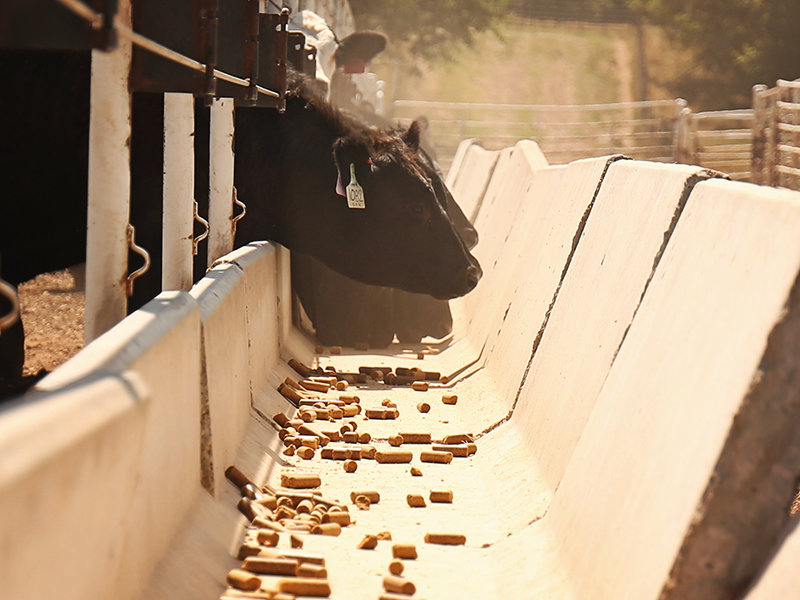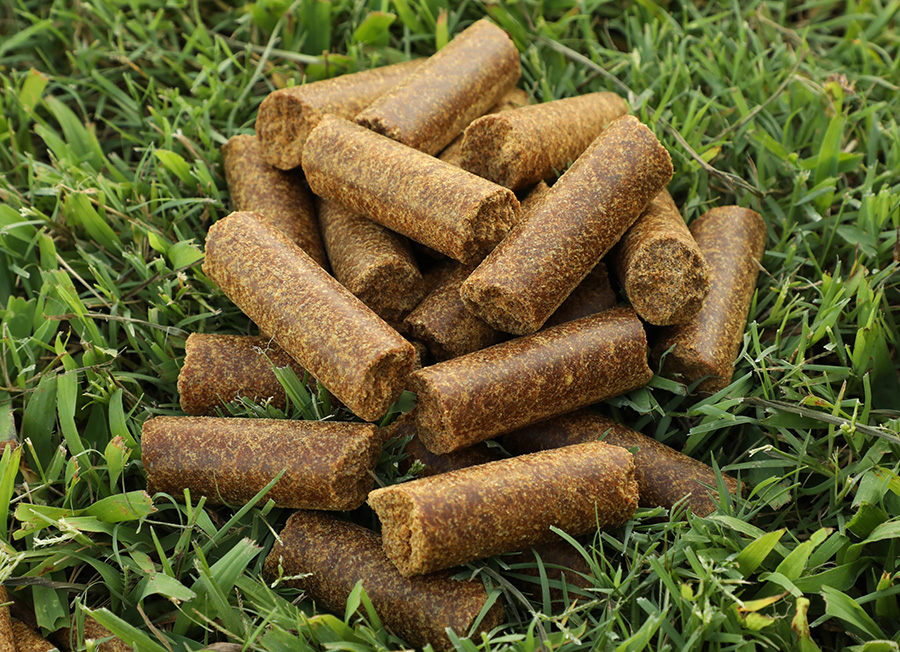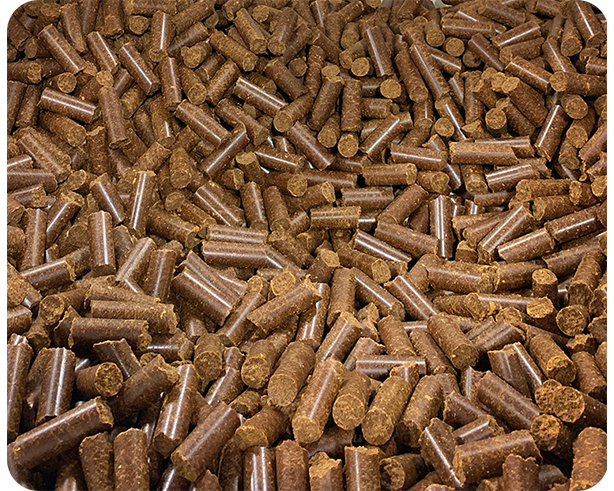Dried Distillers Grains (DDG) have been used in the livestock industry for years as a popular nutritional supplement for cattle. More recently, extrusion technology has brought a new product to the market — extruded DDG cattle range cubes. As with most new products, several misconceptions surround distillers grains and the DDG range cubes. Let’s dive deep into these common myths and set the record straight.
Myth 1: DDG cubes have low nutritional value.
The Misconception: One of the older widespread myths around DDG is that it is essentially a “filler” feed with little nutritional value. This idea stems back to the early 2000s when DDG first came on the market as a cattle feed product and was highly variable in grain sources and production methods.
The Truth: DDG is a byproduct of the ethanol production process. By nature, the fermentation process removes starch from corn, leaving behind DDG which is rich in protein and energy. DDG typically has a protein content ranging between 25% to 35% making it a valuable protein source, especially beneficial during phases when cattle require heightened protein levels. Apart from protein, DDG is high in energy, making it an excellent feed choice during winters or lean grazing periods when cattle require additional energy sources. Additionally, DDG contains phosphorus and other essential minerals that enhance cattle health and resilience. Several research studies, including those from reputable agricultural institutions, have confirmed DDG can be a valuable addition to cattle diets.

Myth 2: DDG cubes are too high in sulfur for safe consumption.
The Misconception: Critics claim that these cubes contain sulfur levels that could be harmful to cattle. In the early days of ethanol production, facilities used sulfuric acid as a cleaning agent. This fact has led to an assumption that the resulting DDGs would inherently contain high sulfur levels.
The Truth: Sulfur is a necessary mineral for cattle, playing a crucial role in many biological processes. It’s essential for the synthesis of amino acids, vitamins, and enzymes. However, like all minerals, balance is vital. Both deficiency and an excess can lead to health complications. While it’s true that some DDGs can have a variable sulfur content based on the source and production methods, reputable suppliers are aware of the safe thresholds and no longer use sulfuric acid in their cleaning process. By sourcing DDGs through trusted suppliers, you’re getting a product that abides by the safety and nutritional standards for cattle feed.
Bonus Truth: It’s always good practice for ranchers to monitor the total sulfur intake of their herd, considering all feed sources. If you’re blending DDGs with other feeds that might also contain sulfur, ensure that the total dietary intake remains within safe limits. Often overlooked, the water source can also contribute to the total sulfur intake. If you’re in an area where the water has naturally high sulfur content, this needs to be factored into the overall diet. Regular testing and adjustments can help balance things out.
Myth 3: DDG cubes are prone to mycotoxin contamination.
The Misconception: This myth stems from the fact that mycotoxins, if present in the original grain used in ethanol production, can become concentrated in the resulting byproducts, including DDGs.
The Truth: Mycotoxins are notorious, naturally occurring toxins produced by certain molds, and they have long been a concern in the agriculture sector, especially when it comes to animal feeds. However, with advancements in ethanol production technology, grain undergoes rigorous quality checks before processing. Producers are well-aware of the risks of mycotoxins, and many have stringent measures in place to ensure that only high-quality grains, free from mold and mycotoxin contamination, enter the production line. Regular testing for mycotoxins is standard practice in the industry. When you choose a trusted supplier, you’re opting for a product that undergoes multiple quality checks to ensure it meets the industry’s stringent safety standards. Mycotoxin formation is more linked to storage conditions than the feed type itself. Proper storage of DDG cubes — ensuring they are kept in cool, dry places and are well-aerated — reduces the risk of mold growth and subsequent mycotoxin production.
Myth 4: DDG cubes are unsustainable and harmful to the environment.
The Misconception: In an era of heightened environmental consciousness, the agricultural sector finds itself under scrutiny. DDG production has not been spared from the spotlight.
The Truth: While any agricultural process, including the production of DDG cattle cubes, will have an environmental impact, it’s essential to view the entire picture. DDG cubes epitomize the principle of making the most of available resources. By transforming what would have been waste into a nutritious feed source, DDG cubes not only support the cattle industry but also promote sustainability. The production process for DDG cattle cubes is less energy-intensive than many alternative feed sources. Furthermore, as they are derived from the ethanol production process, which is increasingly relying on sustainable energy sources, the carbon footprint associated with DDG cubes is comparatively low. Additionally, the water used in ethanol production (and consequently, DDG) is often recycled and reused, making the overall process more water-efficient than perceived. Economically, DDG cubes also offer sustainability. By providing an additional revenue stream for ethanol producers, they help stabilize the market, ensuring long-term viability for producers and affordable prices for ranchers. As with all products, continuous improvements and innovations will further reduce the environmental impact, making DDG cattle cubes an even more sustainable choice in the future.

Myth 5: DDG cubes are more expensive in the long run.
The Misconception: In the cattle industry, every penny counts. With margins often tight, ranchers constantly look for ways to maximize returns without compromising the health and growth of their livestock. It’s not surprising that many are wary of switching feed types, fearing unforeseen costs. The myth here? That while they might seem cost-effective initially, DDG cubes end up being more expensive in the long run.
The Truth: It’s crucial to distinguish between the upfront cost of a product and its long-term value. While DDG cubes might sometimes have a slightly higher upfront price than some other feeds, their nutrient density and efficiency often lead to better weight gain and overall livestock health. This means ranchers may need less feed volume, translating to potential savings over time. Additionally, the nutritional profile of DDG cubes — rich in protein and energy — can contribute to the overall well-being of the livestock. Healthier cattle can mean reduced vet bills, another area of potential long-term savings. One more advantage of DDG cubes is consistency in quality. Traditional feed sources can vary significantly in nutritional value depending on multiple factors like weather conditions, soil health, and pest infestations. Inconsistent feed quality can lead to unpredictable costs. With DDG cubes, ranchers know what they’re getting every time, making budgeting more straightforward.
Conclusion: Making Informed Decisions
Like many innovations in agriculture, DDG cattle cubes come with their share of skepticism. However, once these myths are dispelled, it’s clear to see the potential benefits they offer. When considering any change in cattle feed, it’s crucial to do thorough research, consult with professionals, and make decisions based on facts rather than misconceptions. The potential for increased growth, health benefits, and overall cost savings with DDG cubes makes them worthy of consideration for any modern cattle rancher.


